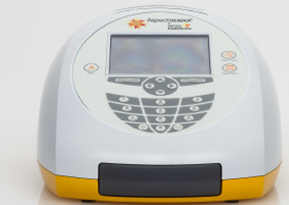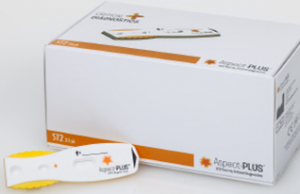

ASPECT Plus – A unique express analyzer that has no analogues in the world market. An easy-to-use immunochromatographic test of the lateral type allows the quantitative determination of sST2 in human plasma (with EDTA) for 20 minutes. The quality of the results obtained is comparable to the ELISA-technique.
A highly sensitive Presage ST2 test is also available – the quantitative determination of the sST2 concentration by the ELISA method (serum, plasma) on open type analyzers.
ST2 – this is the newest marker, used to predict and stratify the risk of developing heart failure (HF), prediction of adverse outcomes and death of patients with confirmed diagnosis of HF, the development of cardiovascular diseases (CVD) in the future in the population as a whole, as well as for monitoring and selecting the most effective therapy for patients with heart failure. ST2 is expressed in the heart in response to pathological changes caused by chronic diseases and / or acute damage. It reflects ventricular remodeling and cardiac fibrosis. Unlike other cardiomarkers, ST2 levels change rapidly in response to the patient’s condition, helping doctors make optimal decisions on the treatment of the patient and, if necessary, quickly make adjustments. The test system for determining ST2 is a simple test for the content of a marker in the blood, helping to assess the risk of patients with HF. The mean normal concentration of ST2 = 18 ng / ml, and concentrations above 35 ng / ml indicates a significant increase in the risk of hospitalization or death. Accordingly, patients with ST2 below the threshold value have a low risk of hospitalization or death. Before the appearance of ST2, the doctors used for the diagnosis of CH sodium nuretic peptides (NT-proBNP and BNP). However, studies have shown that ST2 and natriuretic peptides reflect different biological processes. Being markers of instability of hemodynamics and stretching of myocytes, natriuretic peptides are more suitable for diagnosis, but for patients re-hospitalized for 30 days the prognostic qualities of natriuretic peptides are insufficient. Numerous studies have confirmed the high role of ST2 in the progression of disease and fibrosis. It is shown that ST2 is the most informative and clinically significant prognostic marker. In addition, the level of natriuretic peptides can change in the presence of such factors as age, sex, high BMI, renal failure, anemia, etc.. ST2 did not demonstrate any dependence on such factors.
ST2 and natriuretic peptides reflect the course of 2 different but overlapping biological processes, so markers provide independent and complementary information on the condition of the patient. It has been shown that in the case of an increase in both ST2 and natriuretic peptides, the patient’s condition worsens, he has a high risk of complications and death, he should be assigned more aggressive treatment. If both markers are below their thresholds, we can talk about improving the patient’s condition and the low risk of adverse events. In the same cases, when only one of the two markers is elevated, the patient should be assigned to the high-risk group and appropriate treatment should be given to him.
Over the past few years, a large number of studies around the world have confirmed the high predictive value of ST2. Many countries have already included the ST2 test in their national recommendations for cardiologists and have successfully used the test in routine practice. (2013 ACC / AHA Guideline USA, 2016 ESC Guideline Europe, 2014 China, 2015 Vietnam and Taiwan).
